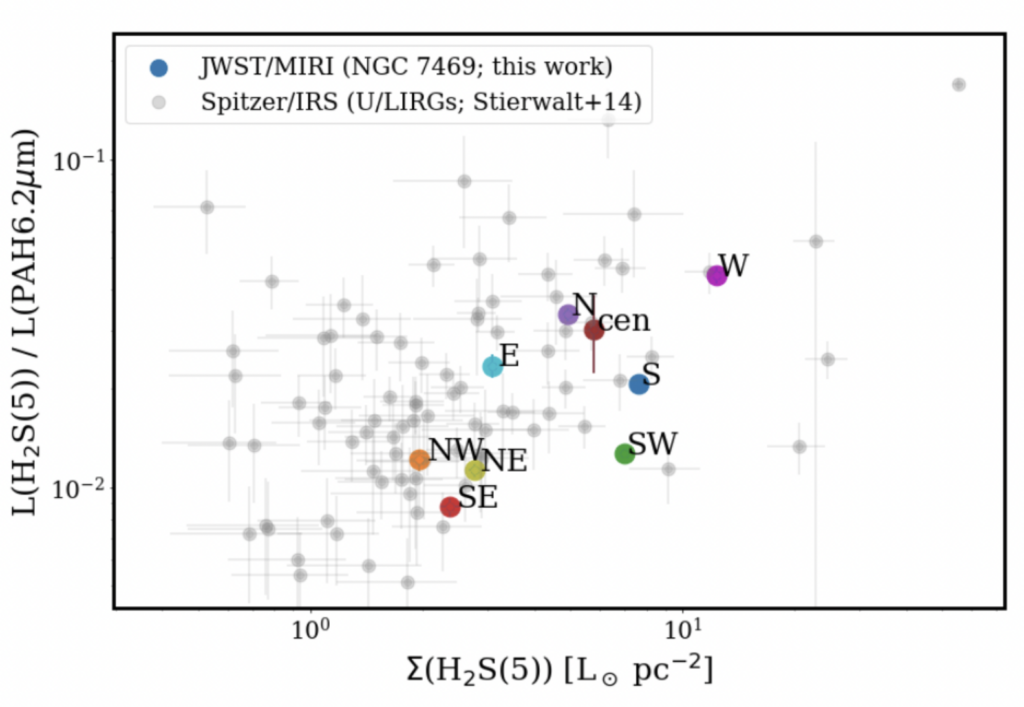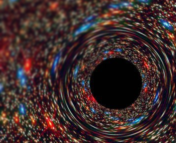Title: GOALS-JWST: Resolving the Circumnuclear Gas Dynamics in NGC 7469 in the Mid-Infrared
Authors: Vivian U et al.
First Author’s Institution: Department of Physics and Astronomy, University of California, Irvine, CA, USA
Status: Submitted to ApJ Letters, available on arXiv
As supermassive black holes accrete matter, they often like to blow off some steam in the form of outflows. These supermassive black holes are thought to power active galactic nuclei (AGN), which are often obscured by dust. Astronomers are interested in how AGN outflows impact a galaxy’s interstellar medium (ISM) and to what extent outflows could trigger or halt star formation in the ISM. Since AGN are often dusty, obscuration can make it difficult to study outflows – at least, until JWST came onto the scene.
Today’s authors inspect NGC 7469 – a nearby galaxy uniquely suited for studying the relationship between AGN outflows and star formation. NGC 7469 contains a Seyfert nucleus surrounded by a ring with active star formation, and to top it off, previous observations show evidence of outflows. With new spectroscopy from JWST, the authors take a detailed look at how the gas and dust of NGC 7469 are affected by AGN outflows.
Hunting for outflows with spectroscopy
With mid-infrared integral field spectroscopy from JWST’s Mid-InfraRed Instrument (MIRI), the authors use several emission lines to study where outflows occur and how they interact with the ISM. In Figure 1, a map of the flux for the emission lines [Fe II], H2, and [Ar II] reveals that while the H2 flux, from molecular gas, is mostly concentrated around the nucleus, while [Fe II] and [Ar II], forbidden lines emitted from ionized gas, are brightest in the ring of NGC 7469.

Taking a closer look at the spectrum in nine regions in a 3×3 grid around the nucleus of NGC 7469 (shown in Figure 2), additional spectral features emerge, including [Mg V] – producing this line requires a lot of energy, and it’s quite bright. What’s more, in the region to the east of NGC 7469’s center, the [Mg V] peak is noticeably shifted to shorter wavelengths (blueshifted) relative to its central region. This blueshifted emission indicates that matter in this region of the galaxy is moving toward us – in other words, there is an outflow of gas in the eastern region of NGC 7469. The outflow only appears to occur in the eastern region, although the authors note that matter could be moving away from us in western region but the redshifted component is too weak to be detected.

How do outflows affect the interstellar medium?
The spectra of NGC 7469 also show lines caused by polycyclic aromatic hydrocarbons (PAHs), molecules that form part of the galaxy’s dust. Although both emission from PAHs and molecular gas is expected to be strong around star-forming regions, PAHs are ripped apart by AGN outflows. The influence of outflows can be traced by taking the ratio of brightness from H2 to emission from PAHs (L(H2)/L(PAH)) – if this ratio is high, then the gas likely has experienced shocks due to an outflow. In Figure 3, the regions to the North and West of the center have the highest ratios of L(H2)/L(PAH) while the regions at the corners of the grid have the lowest ratios. Since the corner regions include the star-forming ring of NGC 7469, their emission from PAHs is expected to be high, while the H2 emission is mostly concentrated in the nucleus. The authors propose that the high L(H2)/L(PAH) in the North and West is the result of shocks in these regions powered by the AGN outflow seen through [Mg V].

With new JWST data, today’s authors took a high resolution view of the gas and dust around NGC 7469’s nucleus and found that an AGN outflow appears to interact with its interstellar medium. As high resolution spectroscopy from JWST allows astronomers to study AGN and their outflows in unprecedented detail, surely more will be discovered about the role of AGN in regulating star formation.





I have a question not relating to this article, but astronomy in general. Let’s say I’m reading the The Saga of Seven Suns. It’s not the best scifi epic I know, but I’m reading it anyway even if it has some significant plot and protagonist problems.
In any case, in there they have a certain instrument that they use to turn gas giants like Jupiter into a burning sun. For this, they open a wormhole to a neutron star to add significant mass bla bla bla (but neutron star mass wouldn’t really help for it already burned, or not?).
What I wonder about is that if Jupiter is all of a sudden a lot heavier, it would throw off the entire solar system, correct? And my question is, are there easy to use simulators / calculators to see what effect it would have on planets orbits?